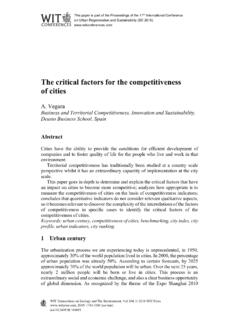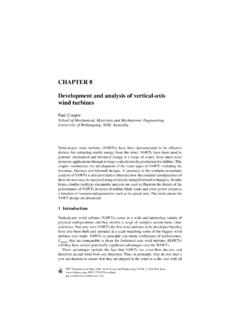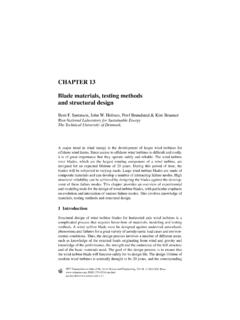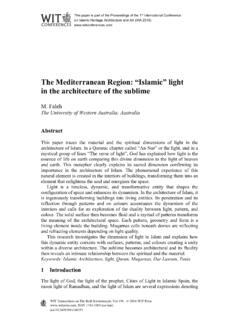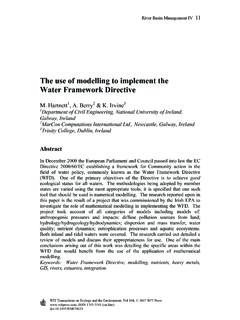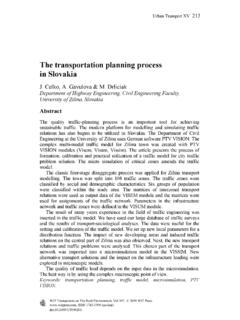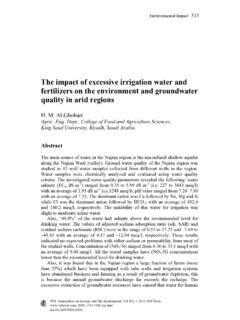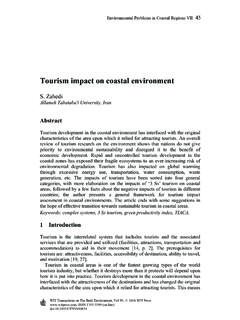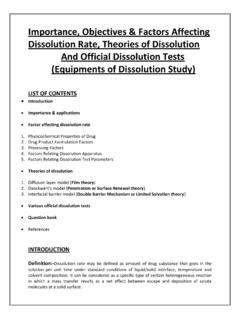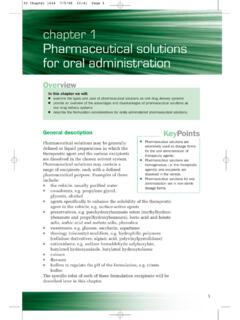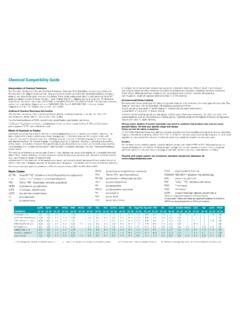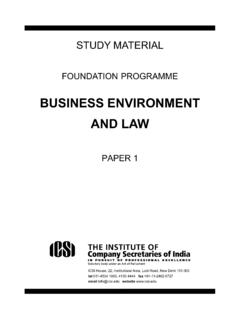Transcription of CHAPTER 1 Environmental factors that influence the ...
1 CHAPTER 1 Environmental factors that influence thedeterioration of materialsA. Moncmanov Faculty of Chemical and Food Technology, Slovak University ofTechnology, Bratislava, Slovak IntroductionThe process of deterioration of materials induced by outdoor Environmental factorsis a complex interplay of the effects of climate and local meteorological charac-teristics, of biological processes and frequently of complicated chemical processesresulting from the impact of pollutants and natural constituents from the surround-ing environment. Except for the decay caused by cataclysmic events, the princi-pal natural Environmental factors affecting the deterioration of materials include,but are not limited to, moisture, temperature, solar radiation, air movement andpressure, precipitation, chemical and biochemical attack, and intrusion by micro-and macro-organisms.
2 Natural factors , together with those expected to be a partof the pollution processes, continuously promote weathering and material decay,including metal evaluation of the influence of each of the Environmental factors in a givensituation requires an understanding of which mechanisms are potentially of concernfor the type of material or structure in question. In general, the main deteriorationmechanisms include: (1) erosion, (2) volume change of the material and the volumechanges of the material in pores, (3) dissolution of a material and the associatedchemical changes, and (4) biological material science, erosion is described as the recession of a surface because ofrepeated localized shock.
3 In an outdoor environment, the erosion of a material isusually affected by suspended abrasive particles, especially by fine solid particlesdriven against the material surface by moving fluids. The surface area to particlesize ratio controls deterioration because for a given volume of material, the smaller , ISSN 1755-8336 (on-line) 2007 WIT PressWIT Transactions on State of the Art in Science and Engineering, Vol 28, Deterioration of Materialsparticle size, the larger is the surface area exposed to erosion (the presence of jointsalso increases a material s surface area).
4 The nature of the fluid flow is likewiseimportant a markedly smaller effect may be observed for laminar flow than forturbulent in the volume of a material are a function of temperature, solar radia-tion and humidity; the volume changes of the material in pores are controlled byhumidity and temperature. The thermal expansion and contraction of a material isinfluenced by temperature variation, which, in outdoor environment depends on theduration and intensity of exposure to the incoming solar radiation and the direc-tion in which the material surface faces (although expansion caused by changes intemperature from day to night or from summer to winter has only a minor effect).
5 Rainfall, fog and wind can cause volume variation due to uneven moisture differential dimensional changes associated with the change in moisture contentcan be observed in different materials that are bonded together. Such dimensionalchanges can have a warping effect. A similar attack may be caused by differentialmoisture content through the layer of a homogeneous material, since the side witha lower moisture content will expand less than that with a higher moisture content(this effect can be observed when rainwater is absorbed on the outdoor surfaceof a material).
6 Water in combination with freezing conditions can lead to a rapiddestruction of certain materials. Water that penetrates into a material may water expands and strong pressure is exerted on the structure of the mate-rial. A climate with temperature fluctuations across the freezing point can causethe most damage, as repeated freezing cycles can effectively destroy the surfacematerial. The degradation process thus depends upon the degree of saturation withwater, the rate and number of freezing cycles, the elastic properties and the strengthof the material, and the pore structure of the contaminants and products of reaction between pollutants and mate-rials can also induce expansion.
7 Chemicals from the surrounding environment canaffect the oxidation of a material into more voluminous forms; surface hygroscopiccontaminants such as salts, metal oxides, and vegetal fibres in which moisture canbe present also play an important role. They can absorb water in different waysincluding: binding using surface energy, sorption with the formation of a hydrate,diffusion of water molecules in the material structure, capillary condensation, andformation of solution. The moisture content of these substances depends on thenature of the substance, the temperature, and the partial pressure of water vapourin the immediate induced damage involves dissolution , oxidation, and hydrolysis.
8 Thedecay is a result of the interaction between material and natural constituents andpollutants and the amount of water present. The interactions will vary depending onthe reactivity of a material, the character of the intercepting surface, the extent ofexposure, and the nature of the contaminants. The chemical changes are enhanced byheat (most chemical reactions proceed more rapidly as the temperature increases);therefore, chemical damage to materials is most prevalent in warm, humid of building materials, especially structures containing carbonates,is most frequently caused by the action of acidic solutions such as rain containing , ISSN 1755-8336 (on-line) 2007 WIT PressWIT Transactions on State of the Art in Science and Engineering, Vol 28, Environmental factors and Deterioration of Materials3carbonic acid or both carbonic acid and sulphuric acid.
9 The overall effect of carbonicacid and sulphuric acid can be extensive weathering of a surface. The crystallizationof dissolved compounds from solutions and the hydration of deposited contaminantsand products formed during the reaction of a material with chemicals accompanycrystallization and hydration pressures. The pressures may be surprisingly high andcan lead to mechanical deterioration of a of a material by atmospheric oxygen leads to chemical changes inthe composition of the material (especially the material surface); for example, thereaction of metal ions with oxygen to form oxides or reaction between a material and water can affect the dissolution of thematerial and/or change of its chemical composition.
10 Hydrolysis leads to a decreasein material cohesion and a change in porous biological factors that cause deterioration include biochemical effects andintrusion by different organisms. A biochemical attack is usually a crucial factorin the biodeterioration of building structures, as the metabolites (such as enzymes,excrements, and faeces) of macro-organisms, plants, and animals living in the mate-rial can affect the material chemically. Hyphae of fungi and lichens and plants rootsystems, which spread through the structures, induce mechanical damage of thestructures.
